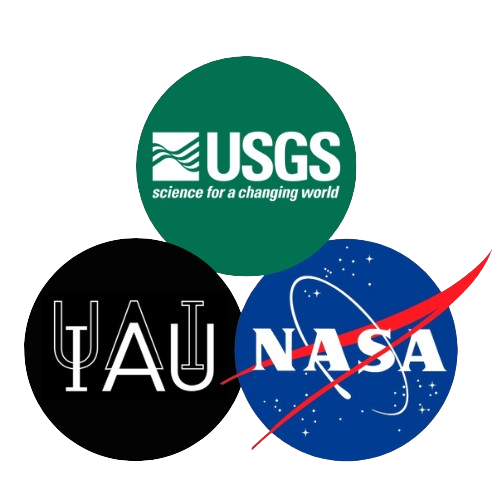Every civilization has had a name for the satellite of Earth that is known, in English, as the Moon. The Moon is known as Luna in Italian, Latin, and Spanish, as Lune in French, as Mond in German, and as Selene in Greek.
Search by Feature Types
- All Features
- Albedo Feature
- Astronaut-named features
- Catena, catenae
- Crater, craters
- Dorsum, dorsa
- Fossa, fossae
- Lacus, lacūs
- Mare, maria
- Mons, montes
- Oceanus, oceani
- Palus, paludes
- Planitia, planitiae
- Promontorium, promontoria
- Rima, rimae
- Rupes, rupēs
- Satellite Feature
- Sinus, sinūs
- Statio
- Vallis, valles

* The Gazetteer of Planetary Nomenclature contains the lettered craters on the Moon from NASA Reference Publication 1097, NASA Catalogue of Lunar Nomenclature, by Leif E. Andersson and Ewen A. Whitaker, 1982. Some spellings in the NASA 1097 have been changed to match the IAU-approved spellings of the parent craters.
Moon Images With Names
Related Resources from USGS Astrogeology
Interactive Images & Maps
- USGS-NASA Planetary Geologic Mapping Program Interactive Maps: Moon: Interactive map of the Moon with a variety of information available for viewing.
Downloads & Information
- Color-Coded Topography and Shaded Relief Map of the Lunar Near Side and Far Side Hemispheres
- Maps & Globes Gallery: Moon
More Resources on the Web
- LROC Quickmap: Interactive map of the Moon with a variety of information available for viewing.
- List of lettered lunar craters: from NASA RP 1097, the NASA catalogue of lunar nomenclature (originally published 1982)
GIS Downloads
Feature boundaries (polygons) are only intended for locating a specific named topographic or morphologic feature, not as precise scientific or geological unit boundaries. No geological interpretation of named features is endorsed by the IAU.
Expected precision for feature coordinates is 2 decimal places. Some landing site features may be captured to 4 decimal places.
The horizontal accuracy can vary largely from planetary body to body. Planetary control networks change regularly as new data is gathered, keeping pace with the latest control networks is an ongoing task for the maintainers.
These files are in the LOLA 2011 control network. (more information)
MOON_nomenclature.zip
MOON.nomenclature.KML


